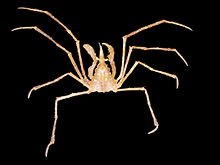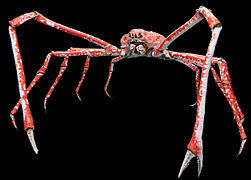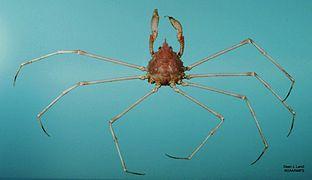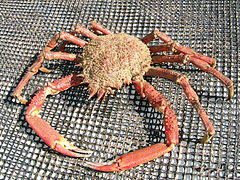| Majoidea | |
|---|---|
 | |
| Macropodia rostrata (Inachidae) | |
| Scientific classification | |
| Kingdom: | Animalia |
| Phylum: | Arthropoda |
| Subphylum: | Crustacea |
| Class: | Malacostraca |
| Order: | Decapoda |
| Infraorder: | Brachyura |
| Superfamily: | Majoidea Samouelle, 1819 |
The Majoidea are a superfamily of crabs which includes the various spider crabs.
Taxonomy
Majoidea comprises five families:[1]
- Epialtidae
- Inachidae
- Inachoididae
- Majidae
- Oregoniidae
The families "Pisidae" and "Tychidae" are now treated as the subfamilies Pisinae and Tychinae of the family Epialtidae, and "Mithracidae" is now treated as the subfamily Mithracinae of the family Majidae.[1]
Classification according to the World Register of Marine Species:
- family Epialtidae MacLeay, 1838
- family Hymenosomatidae MacLeay, 1838
- family Inachidae MacLeay, 1838
- family Inachoididae Dana, 1851
- family Majidae Samouelle, 1819 – "true" spider crabs
- family Mithracidae Balss, 1929
- family Oregoniidae Garth, 1958
- family Pisidae Dana, 1851
Notable species within the superfamily include:
- Japanese spider crab (Macrocheira kaempferi), the largest living species of crab, found on the bottom of the Pacific Ocean.
- Libinia emarginata, the portly spider crab, a species of crab found in estuarine habitats on the east coast of North America.
- Hyas, a genus of spider crabs, including the great spider crab (Hyas araneus), found in the Atlantic and the North Sea.
- Maja squinado, sometimes called the "European long leg crab or pie faced crab" because of the way its face is shaped.
- Australian majid spider crab, found off Tasmania, are known to pile up on each other, the faster-moving crabs clambering over the smaller, slower ones.[2]
There is one fossil family, Priscinachidae, represented by a single species, Priscinachus elongatus, from the Cenomanian of France.[3]
Limnopilos naiyanetri, a Hymenosomatidae
References
- ^ a b Sammy De Grave; N. Dean Pentcheff; Shane T. Ahyong; et al. (2009). "A classification of living and fossil genera of decapod crustaceans" (PDF). Raffles Bulletin of Zoology. Suppl. 21: 1–109. Archived from the original (PDF) on 2011-06-06.
- ^ Martha Holmes & Michael Gunton (2009). Life: Extraordinary Animals, Extreme Behaviour. London: BBC Books. ISBN 9781846076428.
- ^ Gérard Breton (1 September 2009). "Description of Priscinachus elongatus n. gen., n. sp., and Priscinachidae n. fam. for the earliest spider crab (Crustacea, Decapoda, Majoidea), from the French Cretaceous (Cenomanian)" (PDF). Geodiversitas (in French and English). 31 (3): 509–523. doi:10.5252/g2009n3a2.

.jpg)



